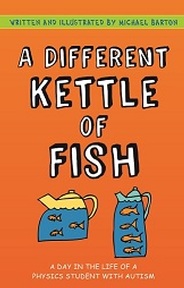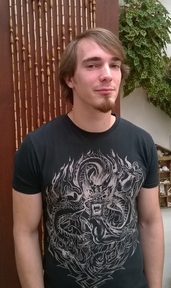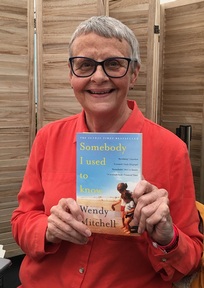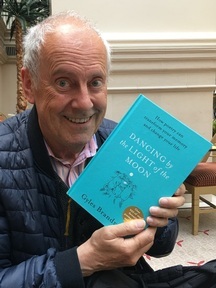Autistic author explores English language from unique perspective in 'A different Kettle of Fish'
 ‘A different Kettle of Fish – A day in the life of a physics student with autism’ is written by Michael Barton and follows his day spent navigating the popular idioms, metaphors and sayings used every day from the perspective of someone living with autism.
‘A different Kettle of Fish – A day in the life of a physics student with autism’ is written by Michael Barton and follows his day spent navigating the popular idioms, metaphors and sayings used every day from the perspective of someone living with autism.
Mr Barton has been described as an interpreter between the viewpoint of those with autism and people described throughout the book as neurotypical, who are not on the autistic spectrum.
Accompanying the text are pictures drawn by the author himself highlighting the absurdity of many phrases we used in common language such as ‘break a leg’ and ‘egg on his face.’ The book is comical as well as informative, providing an insight into the author’s autistic point of view and offering another perspective on everyday life which readers might find surprising.
Mr Barton said: “I believe the book is very important and useful for neurotypical people. It gives them a unique insight into how an autistic person perceives the world around them, as there aren't many autistic people like me that can explain the autistic way of thinking in such a way neurotypical people can understand so easily.”
In the same boat
“‘A Different Kettle of Fish’ was written in the summer holidays while I was at university.”
“I started drawing the pictures for my first book, ‘It's Raining Cats and Dogs’ aged seven because of my very literal way of thinking and this not only helped me to understand these confusing phrases people said, and appreciate the fact that everything isn't supposed to be taken literally, it has also helped others around me to understand the autistic way of thinking.
“My second book was written while I was at university and reflects how I've grown up and developed since my school days. The books have impacted on me mostly in the fact that I'm now more aware of how differently neurotypical people think and the books are therefore a way of other people gaining a better understanding of autism.”
Thinking outside the box
The book takes a light-hearted look at the often random nature of the English language and indicates the variety of ways which meanings can be interpreted. Mr Barton explained what he goes through to find out meanings of sayings which at first do not make sense to him.
He said: “I have learned to work out if something is meant to be figurative or not, judging by how much sense it would make if it was literal. If it doesn't make sense, I often skip the confusing part out and try to piece something together (from the context of the sentence and other information) that would make sense. 
“I have had numerous other people come up with their own examples of expressions and sayings they've found confusing. As for instructions, a lady told me of a fire safety instruction which said, "The last thing you should do to a chip pan fire is pour water on it." This can obviously be interpreted by an autistic person as "The final thing you should do before leaving is pour water on the chip pan fire."
“People discover new sayings quite often, and I am no exception.
“I do use idioms that I have used in my book. I would use them much in the same way neurotypical people would, however I don't think I use these as often as everyone else.”
Breaking the ice
The term ‘early infantile autism’ was first used by Hans Kanner in 1943 in an article titled ‘Autistic Disturbances of Affective Contact’ which provided a clinical account of the lives of 11 children with seriously disordered behaviour. The clinical account is believed to be the first article on autism and many conclusions drawn by Kanner are still believed to be as relevant now as they were over 65 years ago.
The concept of an autistic spectrum was developed by Lorna Wing and Judith Gould in 1979, after the two doctors with expertise in psychology conducted an epidemiology study to discover more about the patterns, causes and effects of autism. People on the autistic spectrum can be very different, with high functioning people able to live independent lives and low functioning people requiring round the clock care. However, all people with autism share a triad of impairments affecting social interaction, social communication and social imagination.
There are approximately 700,000 people with autism living in the UK and it is not only a childhood illness but a serious lifelong condition.
On the same wavelength
Mr Barton explores famous scientists and mathematicians who might have had autistic traits such as Einstein and Turing, and celebrates qualities sometimes shared by other mathematicians and scientists similar to autistic traits such as staying focused for long periods of time and very logical and literal thinking.
He also refers to Hans Asperger, the Austrian paediatrician who published the first definition of Asperger’s syndrome. The book cites a quote from Dr Asperger who said: “I am convinced that autistic people have their place in the organism of the social community. They fulfil their role well, perhaps better than anyone else could, and we are talking of people who as children had the greatest difficulties and caused untold worries to their care-givers.”
Responding to the quote, Mr Barton said: “I could not agree more with that Hans Asperger quote, as well as numerous others that he has said. That quote in particular suggests that the general population needs to be more accommodating of autistic people as they can become extremely valuable members of society.”
“I believe the book is very important and useful for neurotypical people. It gives them a unique insight into how an autistic person perceives the world around them, as there aren't many autistic people like me that can explain the autistic way of thinking in such a way neurotypical people can understand so easily.”
A final note
Mr Barton has recently completed a speaking tour, providing talks on his experiences of being an autistic person at the high end of the spectrum. He is continuing his work to educate more people on autism by sharing the positive parts of living with autism and giving an optimistic view.
He said: “I feel that autism should be a compulsory part of education because it affects one to two per cent of the population. Many people have heard of autism but do not know nearly enough about the condition. There definitely needs to be more awareness and I'm certainly doing my bit by writing these books and speaking at schools, conferences and seminars across the UK. I have just completed a two month UK speaking tour, which was extremely successful in educating a wide range of people.”
Latest Features News
 28-Nov-19
2019 Election: Labour pledges £10.8 bn for free personal care while Boris Johnson sidelines social care
28-Nov-19
2019 Election: Labour pledges £10.8 bn for free personal care while Boris Johnson sidelines social care
 18-Oct-19
Podcast: Wendy Mitchell and dementia: 'My biggest fear is not knowing who my daughters are'
18-Oct-19
Podcast: Wendy Mitchell and dementia: 'My biggest fear is not knowing who my daughters are'
 30-Sep-19
World's oldest diver aged 96 says 'never accept the fact you are getting old'
30-Sep-19
World's oldest diver aged 96 says 'never accept the fact you are getting old'
 27-Sep-19
Exclusive: Care minister backs care workers' call for time off to grieve and attend funerals
27-Sep-19
Exclusive: Care minister backs care workers' call for time off to grieve and attend funerals
 20-Sep-19
Podcast: Gyles Brandreth urges care workers to learn poetry with elderly
20-Sep-19
Podcast: Gyles Brandreth urges care workers to learn poetry with elderly